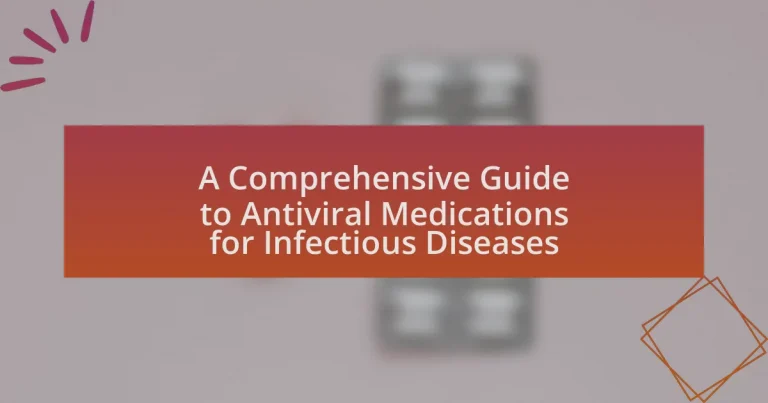Antiviral medications are specialized drugs designed to treat viral infections by inhibiting the development and replication of viruses. This article provides a comprehensive overview of antiviral medications, detailing their mechanisms of action, differences from antibiotics, and their importance in managing various viral infections such as influenza, HIV, and hepatitis. It also explores the development process of these medications, the challenges faced in their creation, and the future of antiviral therapies, including advancements in personalized medicine and technology. Additionally, the article addresses common side effects, best practices for safe usage, and strategies for healthcare providers to optimize antiviral therapy.
What are Antiviral Medications?
Antiviral medications are drugs specifically designed to treat viral infections by inhibiting the development and replication of viruses. These medications target various stages of the viral life cycle, including entry into host cells, replication of viral genetic material, and assembly of new viral particles. For example, drugs like oseltamivir (Tamiflu) are used to treat influenza by blocking the neuraminidase enzyme, which is essential for the virus’s ability to spread within the body. The effectiveness of antiviral medications has been demonstrated in numerous clinical studies, showing significant reductions in the duration and severity of viral infections.
How do antiviral medications differ from antibiotics?
Antiviral medications differ from antibiotics in that antivirals specifically target viral infections, while antibiotics are designed to combat bacterial infections. Antivirals work by inhibiting the development and replication of viruses, such as those causing influenza or HIV, whereas antibiotics disrupt the growth or reproduction of bacteria, like those responsible for strep throat or bacterial pneumonia. This distinction is crucial because using antibiotics to treat viral infections can lead to antibiotic resistance, a significant public health concern.
What are the key mechanisms of action for antiviral medications?
Antiviral medications primarily act through several key mechanisms: inhibiting viral entry, blocking viral replication, and preventing viral assembly and release. These mechanisms disrupt the life cycle of viruses, thereby reducing their ability to infect host cells and propagate. For instance, entry inhibitors prevent viruses from attaching to and entering host cells, while polymerase inhibitors target viral enzymes essential for replication, effectively halting the production of new viral particles. Additionally, protease inhibitors interfere with the processing of viral proteins, which is crucial for the maturation of infectious virions. Collectively, these actions contribute to the effectiveness of antiviral therapies in managing viral infections.
Why are antiviral medications crucial in treating infectious diseases?
Antiviral medications are crucial in treating infectious diseases because they specifically target viral pathogens, inhibiting their replication and spread within the host. By doing so, these medications can reduce the severity and duration of viral infections, ultimately improving patient outcomes. For instance, antiviral drugs like oseltamivir (Tamiflu) have been shown to decrease the duration of influenza symptoms by approximately one day when administered within the first 48 hours of symptom onset. This targeted approach not only alleviates symptoms but also helps prevent complications associated with viral infections, thereby playing a vital role in public health management.
What types of viral infections are treated with antiviral medications?
Antiviral medications are used to treat various types of viral infections, including influenza, HIV/AIDS, herpes simplex virus, hepatitis B and C, and COVID-19. These medications specifically target the replication processes of viruses, inhibiting their ability to multiply and spread within the host. For instance, antiviral drugs like oseltamivir are effective against influenza, while antiretroviral therapy is crucial for managing HIV/AIDS. Additionally, direct-acting antivirals have been developed for hepatitis C, demonstrating high cure rates. The effectiveness of these treatments is supported by clinical studies that show significant reductions in viral load and improved patient outcomes.
Which antiviral medications are effective against influenza?
Oseltamivir, zanamivir, peramivir, and baloxavir marboxil are antiviral medications effective against influenza. Oseltamivir, commonly known as Tamiflu, is an oral medication that inhibits the neuraminidase enzyme, preventing the virus from spreading in the body. Zanamivir, administered via inhalation, also targets neuraminidase. Peramivir is an intravenous option that provides rapid treatment for severe cases. Baloxavir marboxil works by inhibiting the cap-dependent endonuclease, disrupting viral replication. Clinical studies have demonstrated the efficacy of these medications in reducing the duration of influenza symptoms and preventing complications.
What antiviral options are available for HIV treatment?
Antiviral options available for HIV treatment include antiretroviral therapy (ART), which consists of several classes of medications. These classes are nucleoside reverse transcriptase inhibitors (NRTIs), non-nucleoside reverse transcriptase inhibitors (NNRTIs), protease inhibitors (PIs), integrase strand transfer inhibitors (INSTIs), and entry inhibitors. ART effectively reduces viral load, improves immune function, and decreases the risk of HIV transmission. According to the World Health Organization, consistent use of ART can lead to viral suppression in over 90% of patients, demonstrating its efficacy in managing HIV.
What are the common side effects of antiviral medications?
Common side effects of antiviral medications include nausea, diarrhea, headache, and fatigue. These side effects occur as the body reacts to the medication, which can interfere with normal cellular processes. For instance, nausea and diarrhea are frequently reported with medications like oseltamivir, while headache and fatigue can be associated with various antiviral agents such as acyclovir. Understanding these side effects is crucial for managing patient care effectively.
How do side effects vary among different antiviral drugs?
Side effects vary significantly among different antiviral drugs due to their distinct mechanisms of action and chemical structures. For example, while acyclovir primarily causes gastrointestinal disturbances and renal toxicity, oseltamivir may lead to nausea and neuropsychiatric effects. Additionally, drugs like ribavirin can result in hemolytic anemia and teratogenic effects, highlighting the diverse range of adverse reactions associated with antiviral therapies. This variability underscores the importance of individualized treatment plans and monitoring for side effects based on the specific antiviral agent used.
What precautions should be taken when using antiviral medications?
When using antiviral medications, it is crucial to follow specific precautions to ensure safety and effectiveness. Patients should consult healthcare professionals before starting antiviral therapy to confirm the appropriateness of the medication for their condition. Additionally, individuals must adhere to the prescribed dosage and schedule, as deviations can lead to reduced efficacy or increased resistance. Monitoring for side effects is essential; common adverse reactions may include nausea, diarrhea, or allergic reactions, and any severe symptoms should prompt immediate medical attention. Furthermore, patients should disclose their complete medical history, including any other medications or supplements they are taking, to avoid potential drug interactions. Lastly, pregnant or breastfeeding individuals should seek specialized advice, as some antivirals may pose risks to the fetus or infant.
How are Antiviral Medications Developed?
Antiviral medications are developed through a systematic process that includes target identification, compound screening, preclinical testing, and clinical trials. Initially, researchers identify viral targets, such as specific proteins or enzymes essential for the virus’s replication. Following this, high-throughput screening is conducted to find compounds that can inhibit these targets. Promising candidates undergo preclinical testing in vitro and in animal models to evaluate their efficacy and safety. Successful candidates then progress to clinical trials, which are conducted in phases to assess safety, dosage, and effectiveness in humans. This rigorous process is essential to ensure that antiviral medications are both effective and safe for public use.
What is the process of antiviral drug discovery?
The process of antiviral drug discovery involves several key stages: target identification, lead compound discovery, preclinical testing, and clinical trials. Initially, researchers identify viral targets, such as specific proteins or enzymes essential for viral replication. Following this, lead compounds are discovered through high-throughput screening or rational drug design, which involves creating molecules that can inhibit the identified targets.
Once promising candidates are identified, they undergo preclinical testing to evaluate their safety and efficacy in vitro and in animal models. Successful candidates then progress to clinical trials, which are conducted in three phases to assess safety, dosage, and effectiveness in humans. Each phase must demonstrate positive results before moving to the next, ultimately leading to regulatory approval for the antiviral drug. This structured approach is supported by historical successes, such as the development of antiretroviral therapies for HIV, which followed a similar discovery process.
How do researchers identify potential antiviral compounds?
Researchers identify potential antiviral compounds through a combination of high-throughput screening, computational modeling, and structure-based drug design. High-throughput screening involves testing thousands of compounds against viral targets to observe inhibitory effects, while computational modeling predicts how compounds interact with viral proteins. Structure-based drug design utilizes the three-dimensional structures of viral proteins to create compounds that can effectively bind and inhibit viral replication. These methods are supported by historical successes, such as the identification of protease inhibitors for HIV, which were discovered through similar screening and design techniques.
What role do clinical trials play in antiviral medication development?
Clinical trials are essential in the development of antiviral medications as they rigorously evaluate the safety and efficacy of these drugs in human subjects. These trials follow a structured process, typically divided into phases, where Phase I assesses safety, Phase II evaluates efficacy and side effects, and Phase III confirms effectiveness in larger populations. For instance, the clinical trial for the antiviral drug Remdesivir demonstrated its ability to reduce recovery time in COVID-19 patients, leading to its emergency use authorization by regulatory bodies. Thus, clinical trials provide the necessary evidence to support the approval and clinical use of antiviral medications.
What challenges are faced in developing antiviral medications?
Developing antiviral medications faces several significant challenges, including the rapid mutation rates of viruses, which can lead to drug resistance. For instance, the influenza virus can change its genetic makeup quickly, making existing antiviral treatments less effective. Additionally, the complexity of viral life cycles complicates the identification of effective targets for drug action. Furthermore, the lengthy and costly process of clinical trials, often taking over a decade and requiring substantial financial investment, poses a barrier to bringing new antiviral drugs to market. Regulatory hurdles also add to the challenges, as demonstrating safety and efficacy in diverse populations can be difficult. These factors collectively hinder the timely development of effective antiviral therapies.
How does viral resistance impact antiviral drug development?
Viral resistance significantly impacts antiviral drug development by necessitating the continuous modification and innovation of therapeutic agents. As viruses evolve mechanisms to evade the effects of existing antiviral drugs, pharmaceutical researchers must identify new targets and develop alternative compounds to maintain efficacy. For instance, the emergence of resistant strains of HIV has led to the development of combination therapies, which reduce the likelihood of resistance by attacking the virus through multiple pathways simultaneously. This adaptive response to viral resistance underscores the importance of ongoing surveillance and research in the field, as evidenced by studies showing that resistance mutations can arise within weeks of treatment initiation, highlighting the urgent need for novel antiviral strategies.
What are the regulatory hurdles for new antiviral medications?
Regulatory hurdles for new antiviral medications include extensive clinical trial requirements, safety and efficacy evaluations, and compliance with manufacturing standards. The U.S. Food and Drug Administration (FDA) mandates that antiviral drugs undergo rigorous phases of clinical trials to demonstrate their effectiveness and safety before approval. Additionally, the regulatory process involves submitting a New Drug Application (NDA) that includes comprehensive data on the drug’s pharmacology, toxicology, and clinical results. The complexity of these requirements can delay the availability of new antiviral treatments, as seen in the lengthy approval timelines for drugs like remdesivir during the COVID-19 pandemic.
What is the Future of Antiviral Medications?
The future of antiviral medications is focused on the development of more effective and targeted therapies, particularly through advancements in personalized medicine and novel drug discovery techniques. Research indicates that the integration of genomics and proteomics will enable the identification of specific viral targets, leading to the creation of antiviral agents that are more efficient and have fewer side effects. For instance, the success of direct-acting antivirals in treating hepatitis C has set a precedent for similar approaches in other viral infections, such as HIV and influenza. Additionally, the rapid response to emerging viral threats, as demonstrated during the COVID-19 pandemic with the development of antiviral treatments like remdesivir and molnupiravir, highlights the potential for accelerated drug development processes in the future.
How are advancements in technology influencing antiviral treatments?
Advancements in technology are significantly enhancing antiviral treatments by enabling faster drug discovery, improving precision medicine, and facilitating real-time monitoring of viral infections. For instance, high-throughput screening techniques allow researchers to rapidly test thousands of compounds for antiviral activity, leading to quicker identification of potential treatments. Additionally, technologies such as CRISPR gene editing are being explored to develop targeted therapies that can disrupt viral replication at the genetic level. Furthermore, artificial intelligence is increasingly used to analyze vast datasets, predicting viral mutations and optimizing treatment protocols. These technological innovations are supported by studies demonstrating their effectiveness, such as the use of machine learning algorithms to identify novel antiviral compounds, which has been shown to accelerate the drug development process significantly.
What role do personalized medicine and genomics play in antiviral therapy?
Personalized medicine and genomics significantly enhance antiviral therapy by tailoring treatments based on individual genetic profiles. This approach allows for the identification of specific viral strains and the patient’s unique response to medications, leading to more effective and targeted therapies. For instance, genomic sequencing can reveal mutations in viral genomes that confer resistance to standard antiviral drugs, enabling clinicians to select alternative therapies that are more likely to succeed. Studies have shown that personalized antiviral regimens can improve treatment outcomes and reduce adverse effects, as they align more closely with the patient’s biological makeup and the characteristics of the virus involved.
How might emerging viruses shape the future of antiviral drug development?
Emerging viruses will significantly influence the future of antiviral drug development by necessitating rapid adaptation and innovation in therapeutic strategies. The emergence of viruses such as SARS-CoV-2 has highlighted the need for flexible drug development frameworks that can quickly respond to new viral threats. For instance, the use of platform technologies, like mRNA vaccines and antiviral compounds that can be rapidly modified, has been accelerated due to the COVID-19 pandemic. This shift is supported by the fact that the global response to COVID-19 led to the fastest vaccine development in history, demonstrating the potential for expedited antiviral drug development in response to emerging pathogens.
What are the best practices for using antiviral medications effectively?
The best practices for using antiviral medications effectively include adhering to prescribed dosages, starting treatment promptly after infection onset, and completing the full course of medication. Adhering to prescribed dosages ensures optimal therapeutic effects and minimizes the risk of resistance. Starting treatment promptly, ideally within 48 hours of symptom onset, significantly improves outcomes, as evidenced by studies showing reduced severity and duration of illness. Completing the full course prevents relapse and resistance development, which is critical in managing viral infections.
How can patients ensure they are using antiviral medications safely?
Patients can ensure they are using antiviral medications safely by following their healthcare provider’s instructions precisely. Adhering to prescribed dosages and schedules minimizes the risk of resistance and maximizes effectiveness. Additionally, patients should disclose their complete medical history, including any other medications or supplements they are taking, to avoid harmful interactions. Monitoring for side effects and reporting any adverse reactions to a healthcare professional is crucial for safe usage. Research indicates that proper adherence to antiviral regimens can significantly improve treatment outcomes and reduce complications associated with infectious diseases.
What strategies can healthcare providers employ to optimize antiviral therapy?
Healthcare providers can optimize antiviral therapy by implementing personalized treatment plans based on patient-specific factors such as genetics, comorbidities, and viral resistance patterns. Tailoring antiviral regimens to individual patient profiles enhances efficacy and minimizes adverse effects. For instance, pharmacogenomic testing can identify patients who may benefit from specific antiviral agents, thereby improving treatment outcomes. Additionally, regular monitoring of viral load and adherence to therapy can help adjust treatment strategies in real-time, ensuring that the chosen antiviral remains effective against the virus. Studies have shown that personalized approaches lead to better clinical outcomes in managing viral infections, underscoring the importance of these strategies in optimizing antiviral therapy.





